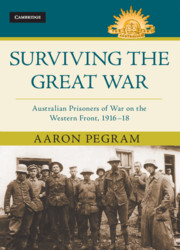Book contents
- Surviving the Great War
- Other titles in the Australian Army History Series
- Surviving the Great War
- Copyright page
- Contents
- Figures, maps and tables
- Preface
- Acknowledgements
- A note on casualty statistics
- Glossary
- Map
- Introduction
- Chapter 1 Raising the white flag
- Chapter 2 The reciprocity principle
- Chapter 3 Giving the game away
- Chapter 4 Saving lives
- Chapter 5 Challenging the Holzminden illusion
- Chapter 6 Well fed and plenty of freedom
- Chapter 7 Hun haunted?
- Conclusion
- Book part
- Notes
- Bibliography
- Index
Conclusion
Published online by Cambridge University Press: 12 November 2019
- Surviving the Great War
- Other titles in the Australian Army History Series
- Surviving the Great War
- Copyright page
- Contents
- Figures, maps and tables
- Preface
- Acknowledgements
- A note on casualty statistics
- Glossary
- Map
- Introduction
- Chapter 1 Raising the white flag
- Chapter 2 The reciprocity principle
- Chapter 3 Giving the game away
- Chapter 4 Saving lives
- Chapter 5 Challenging the Holzminden illusion
- Chapter 6 Well fed and plenty of freedom
- Chapter 7 Hun haunted?
- Conclusion
- Book part
- Notes
- Bibliography
- Index
Summary
This book has argued that Germany’s treatment of Allied prisoners during the First World War was neither brutal nor benign, but somewhere in between. Through the experiences of Australian prisoners of war captured on the Western Front, we see that Germany largely adhered to the pre-war agreements as best it could. Although there were cases of deliberate mistreatment, ex-prisoners of war testified that their captors had largely treated them humanely, provided them with food, shelter and medical assistance, and respected the rank of captured officers.
Keywords
- Type
- Chapter
- Information
- Surviving the Great WarAustralian Prisoners of War on the Western Front 1916–18, pp. 174 - 177Publisher: Cambridge University PressPrint publication year: 2019

